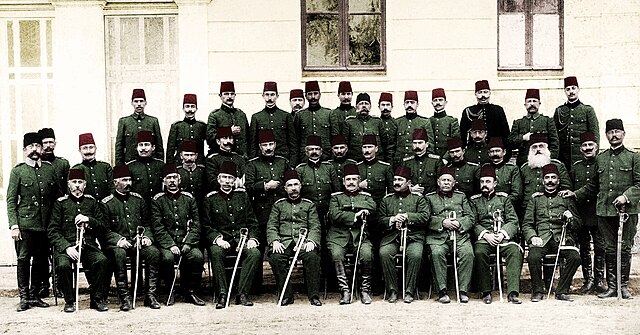Top Qs
Timeline
Chat
Perspective
Action Army
Group within the Ottoman Army which suppressed the 1909 countercoup From Wikipedia, the free encyclopedia
Remove ads
The Action Army (Turkish: Hareket Ordusu), also translated as the Army of Action or Operation Army, was a rebellion force formed by elements of the Ottoman Army sympathetic to the Committee of Union and Progress (CUP) during the 31 March Incident, sometimes referred to as the 1909 countercoup. Mobilised in Selanik (modern Thessaloniki) by Mahmud Shevket Pasha,[1] it occupied Istanbul and successfully suppressed the uprising in the 31 March Incident.[2]
You can help expand this article with text translated from the corresponding article in Turkish. (November 2020) Click [show] for important translation instructions.
|

Remove ads
Background

The 1908 Young Turk Revolution, led by the Committee of Union and Progress, forced Sultan Abdul Hamid II to restore a system of constitutional monarchy, ushering in the Second Constitutional Era. The 1909 countercoup was instigated by a mutiny of dissatisfied troops in Istanbul, who were joined by reactionary religious protestors demanding a return to autocracy under Abdul Hamid and sharia (sacred law).[3] With the resignation of Hüseyin Hilmi Pasha's cabinet the mutiny developed into a wider political crisis.[4]
Remove ads
Composition
The Action Army was organised by Mahmud Shevket Pasha, commander of the Third Army based in Selanik. A number of staff officers opposed to the countercoup gathered in Selanik to join the force.[5] It was also supported by divisions from the Second Army stationed in Adrianople (modern Edirne).[5]

The force numbered around 20,000–25,000 Ottoman soldiers and was supplemented by 15,000 volunteers, including 4,000 Bulgarians, 2,000 Greeks and 700 Jews. Çerçiz Topulli and Bajram Curri brought 8,000 Albanians troops, and Major Ahmed Niyazi Bey arrived with 1,800 men from Resne.[6]
Remove ads
Legacy

Some have compared the Action Army to a band of marauders (çapulcu in Turkish).[7] One such example is Shaykh Nazim in some of his discourses. Mustafa Kemal Bey was involved as a captain.[8]
Marching song
Remove ads
References
Wikiwand - on
Seamless Wikipedia browsing. On steroids.
Remove ads
